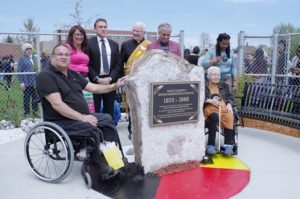Unveiling of residential school memorial site a ‘sad and happy occasion’

By Rick Garrick
THUNDER BAY — Former Long Lake #58 Chief Allen Towegishig says the June 5 official unveiling of the St. Joseph’s Indian residential school memorial site in Thunder Bay was a “sad and happy occasion.”
“It’s sad what happened with all of those things that [Elder Dolores Wawia] was talking about,” says Towegishig, a survivor of the former residential school. “Now we’re happy that people get to understand and be able to do something about it. I remember a long time ago, there was another place, Pelican Falls (residential school), where a lady was speaking and said this is where a residential school was. Now it’s not here — you’re not here, but we’re still all here.”
The memorial is located on Arthur St. at the southwest corner of the Thunder Bay Catholic District School Board’s Pope John Paul II School grounds, where the residential school was located.
Towegishig says the upcoming Healing Walk for all First Nations and Communities, which is scheduled from June 23-29 between Ginoogaming and Fort William, includes a focus on residential school/day school survivors and their descendants on the day they cross over the Nipigon River Bridge and on Missing and Murdered Indigenous Women and Girls on the final day.
“Our guide is going to be the ancestors,” Towegishig says. “This is our third one — they all went well because we get support from the people.”
Wawia, a survivor of the residential school and former professor at Lakehead University, spoke about how she was taken away from her family when she was five-years-old and forced to attend the residential school.
“A couple of years later I was sick, I had tuberculosis and they sent me to the Fort William Sanitorium for five years,” Wawia says. “So I didn’t see my mom and dad at all or my brothers and sisters. I was 11-years-old … when I was released from the Fort William Sanatorium and taken right to St. Joseph’s residential school.”
Wawia also described some of the good and bad experiences she had at the residential school.
“When I look back now, all I can say is that whatever life gives you, learn from it,” Wawia says. “If life gives you lemons, make lemonade.”
Fort William Councillor Phil Pelletier, who is also a board member with the Thunder Bay Catholic District School Board, says he has “very mixed emotions” about the residential school as his father was a survivor.
“He would never talk about this place, and we never ever pushed him,” Pelletier says. “But for the Catholic Board, we are educating our students, so we go forward in the future. And the more education we provide about the past will help us in the long-term.”
Pino Tassone, director of education with the Thunder Bay Catholic District School Board, says the treatment of students in residential schools was “an extremely dark period” in Canada’s history.
“As a parent and educator, I cannot fathom the fear, the unhappiness and the uncertainties these students and families faced,” Tassone says. “The agony can still be felt through survivor’s stories and their heartache is something many of us will never be able to comprehend. Today’s unveiling of this memorial monument has been years in the making — although this tribute is long overdue, it is not nearly enough. It will never cure the nightmares, griefs or the injustices that Indigenous peoples endured.”
Tassone says he prays the memorial will become a representation of hope and reconciliation.
“A reminder that our past is never forgotten and never repeated,” Tassone adds.


